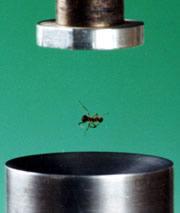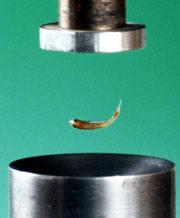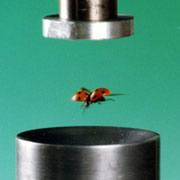 Flying ants: ultrasound can keep a small insect aloft.Wenjun Xie
Flying ants: ultrasound can keep a small insect aloft.Wenjun XieIn northern China there are flying fish and flying ants like you've never seen before. Scientists at Northwestern Polytechnical University in Xian have used sound waves to levitate these and other small creatures while they are still alive, without causing them any apparent harm.
Or nearly so. Wen-Jun Xie and his colleagues admit that "the vitality of the fish is reduced" by levitation, because it couldn't be kept immersed in a levitated pool of water despite their efforts to squirt it with a syringe. But ants, ladybirds, spiders and bees seemed to emerge none the worse for wear.
It's not the first time living creatures have been treated to such an uplifting experience. In 1997 physicists at the University of Nijmegen in the Netherlands levitated a frog using a strong magnet to induce weak magnetism in the frog's tissues, producing a repulsive magnetic force.
Superconductors may also induce levitation because of their ability to repel magnetic fields. This effect has been used in Japan to support a hovering metal plate with a sumo wrestler standing on it. The same effect is being explored for magnetically levitated trains, although current Maglev trains use conventional electromagnetism to generate the repulsive force.
 Tiny fish can try to swim away, but they won't succeed — not without water.Wenjun Xie
Tiny fish can try to swim away, but they won't succeed — not without water.Wenjun XieAcoustic levitation is less exotic. It uses the air pressure of ultrasound waves (sound with frequencies higher than the range of human hearing) to keep an object aloft. The effect has been recognized in theory since at least the 1930s, and Xie and his colleague Bing-Bo Wei have previously used it to levitate very dense balls of tungsten.
Size small
The levitating force is strongest when the object is about the same size as the wavelength of the ultrasound waves. The Chinese researchers excite ultrasound using a magnet that quickly contracts and rebounds to its original shape when placed in an oscillating electric field, pushing out pulses of air with a wavelength of 20 millimetres — about the right size for levitating animals ranging from ants to small fish.
Although largely unharmed, the animals seem understandably perturbed by their experience of floating in mid-air. The ant tried to walk away, thrashing its legs in the air, while the ladybird spread its wings and the fish and tadpole attempted to swim — all equally futile gestures.
 Ladybird aloft: squished, but not harmed.Wenjun Xie
Ladybird aloft: squished, but not harmed.Wenjun Xie"I'm not surprised there was no harm," says Peter Christianen, who works on magnetic levitation at the Nijmegen lab where a frog was levitated. "The forces of gravity are very small" — so negating them doesn't require much of a counterthrust, he says.
Xie and colleagues estimate that the pressures exerted on a ladybird, for example, would slightly compress the central region of the back and belly. They have observed this flattening effect with levitating liquid drops before. But the force is probably too small to cause any injury, they say.
Pick me up
The result is more than just a high-tech circus trick. Crystals that form while levitated may be more free from flaws, and free-floating materials that don't come into contact with the walls of a container can avoid contamination, or allow liquids to be supercooled without an external stimulus tripping them into a frozen state.
ADVERTISEMENT
Why levitate living creatures, though? In principle this could mimic some of the effects of a weightless environment, such as that incurred in human space travel, on bones and tissues. It would be very hard to scale up acoustic levitation for humans, but small mammals such as mice might conceivably be kept aloft this way.
At this point, however, the primary value of the work is probably to generate striking publicity shots. "When you levitate something like a frog or a strawberry," says Christianen, "people know how big it is and can have a sense of the strength of the effect."
Visit our animalslevitatedbysou.html">newsblog to read and post comments about this story.
-
References
- Xie W. J., et al. Appl. Phys. Lett., 89 . 214102 (2006). | Article |
